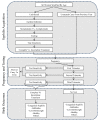Prioritizing congenital syphilis control in south China: a decision analytic model to inform policy implementation
- PMID: 23349624
- PMCID: PMC3551934
- DOI: 10.1371/journal.pmed.1001375
Prioritizing congenital syphilis control in south China: a decision analytic model to inform policy implementation
Abstract
Background: Syphilis is a major public health problem in many regions of China, with increases in congenital syphilis (CS) cases causing concern. The Chinese Ministry of Health recently announced a comprehensive 10-y national syphilis control plan focusing on averting CS. The decision analytic model presented here quantifies the impact of the planned strategies to determine whether they are likely to meet the goals laid out in the control plan.
Methods and findings: Our model incorporated data on age-stratified fertility, female adult syphilis cases, and empirical syphilis transmission rates to estimate the number of CS cases associated with prenatal syphilis infection on a yearly basis. Guangdong Province was the focus of this analysis because of the availability of high-quality demographic and public health data. Each model outcome was simulated 1,000 times to incorporate uncertainty in model inputs. The model was validated using data from a CS intervention program among 477,656 women in China. Sensitivity analyses were performed to identify which variables are likely to be most influential in achieving Chinese and international policy goals. Increasing prenatal screening coverage was the single most effective strategy for reducing CS cases. An incremental increase in prenatal screening from the base case of 57% coverage to 95% coverage was associated with 106 (95% CI: 101, 111) CS cases averted per 100,000 live births (58% decrease). The policy strategies laid out in the national plan led to an outcome that fell short of the target, while a four-pronged comprehensive syphilis control strategy consisting of increased prenatal screening coverage, increased treatment completion, earlier prenatal screening, and improved syphilis test characteristics was associated with 157 (95% CI: 154, 160) CS cases averted per 100,000 live births (85% decrease).
Conclusions: The Chinese national plan provides a strong foundation for syphilis control, but more comprehensive measures that include earlier and more extensive screening are necessary for reaching policy goals.
Conflict of interest statement
The authors have declared that no competing interests exist.
Figures


References
-
- Tucker JD, Chen XS, Peeling RW (2010) Syphilis and social upheaval in china. N Engl J Med 362: 1658–1661. - PubMed
-
- Watson-Jones D, Changalucha J, Gumodoka B, Weiss H, Rusizoka M, et al. (2002) Syphilis in pregnancy in tanzania. I. Impact of maternal syphilis on outcome of pregnancy. J Infect Dis 186: 940–947. - PubMed
-
- Hawkes S, Matin N, Broutet N, Low N (2011) Effectiveness of interventions to improve screening for syphilis in pregnancy: a systematic review and meta-analysis. Lancet Infect Dis 11: 684–691. - PubMed
Publication types
MeSH terms
Grants and funding
LinkOut - more resources
Full Text Sources
Other Literature Sources

